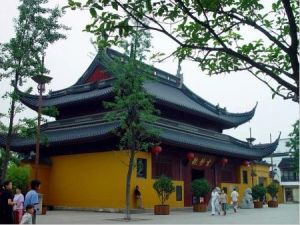Xuanmiao Guan
Located in central Suzhou, the Xuanmiao Guan (玄妙观Profundity and Subtlety Temple) is as famous as Shanghai's City God Temple and Nanjing's Confucian Temple and is older than both. Historical records say that the Profundity and Subtlety Temple, originally called Zhenqing Temple, was first built in 276, the second year of the Xianning reign period in the Western Jin Dynasty. During the Yuan Dynasty, it was given its present name, which was taken from a section of The Book of Lao Zi (Tao Te Ching) that reads: "The deepest and most profound is the doorway to all subtleties."
After being renovated and expanded between the Tang and Qing dynasties, the temple became the largest temple in the areas south of the Yangtze River. During Emperor Chengzong’s reign (1294-1307) in the Yuan Dynasty, the emperor recognized the temple as one of China’s eight biggest Daoist temples. Qing Dynasty Emperor Qianlong once stayed there during his inspection tour in the south.
The Hall of the Three Pristine Ones, the temple’s main hall, is open for religious activities. It was built in 1179, the sixth year of Emperor Chunxi’s reign during the Southern Song Dynasty. It is nine bays wide and six bays deep. Inside stands a dais with a shrine for worshiping Daoism’s greatest deities, the Three Pristine Ones. The gilded statues are seven m tall and are splendid examples of Song Dynasty religious sculpture.
In front of the Hall of the Three Pristine Ones is the Dingding Stone Balustrade, the best balustrade in Suzhou. The balustrade was built during the Five Dynasties period (907-960) and comprises 38 pillars with lotus decorations, 30 hollow guardrails, 12 stone seats with relief sculptures, and 6 slanting guardrails. These enhance the beauty of the Hall of the Three Pristine Ones, with its yellow walls, black tiles and reddish-brown doors and lintels.
The Lao Zi stele was the most precious relic preserved in the temple. On the stele was carved a portrait of Lao Zi by Wu Daozi, a famous Tang Dynasty painter, and an ode written by Emperor Xuanzong and inscribed by Tang Dynasty calligrapher Yan Zhenqing (708-784). The original stele was destroyed in the chaos of war, and a replica was made in 1225, the first year of the Southern Song Dynasty’s Baoqing reign period, by the outstanding stonecutter Zhang Yundi.
On the east side of the Hall of the Three Pristine Ones stands the Fang Xiaoru Stele, one of China’s four most renowned steles with no inscriptions. It is 6.7 m tall and 2.7 m wide. It once had an inscription, an epigraph written by the Ming Dynasty official Fang Xiaoru in which he recorded many historical events that took place in 1371, the fourth year of Hongwu’s reign. Zhu Di, Prince of Yan, later usurped the throne from his nephew Zhu Yunwen and asked Fang Xiaoru to draft an imperial edict on his enthronement. But Fang refused, whereupon Zhu Di had Fang and all of his family executed. Zhu Di even had the Fang’s inscription erased, leaving nothing on the stele.
The temple’s Daoist music has enjoyed great fame for a long time. It has absorbed folk music and been influenced by the Daoist music of the Tianshi (Celestial Master) tradition of Mount Longhu in Jiangxi Province.
